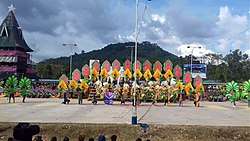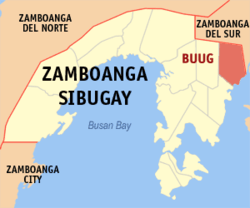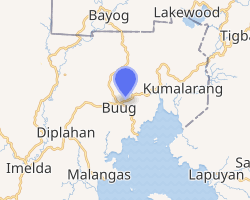Buug
Buug, officially the Municipality of Buug (Cebuano: Lungsod sa Buug; Chavacano: Municipalidad de Buug; Tagalog: Bayan ng Buug), is a 3rd class municipality in the province of Zamboanga Sibugay, Philippines. According to the 2015 census, it has a population of 36,634 people.[3]
Buug | |
|---|---|
| Municipality of Buug | |
 A streetdance performance during Bog Festival | |
 Map of Zamboanga Sibugay with Buug highlighted | |
OpenStreetMap 
| |
.svg.png) Buug Location within the Philippines | |
| Coordinates: 7°44′N 123°04′E | |
| Country | Philippines |
| Region | Zamboanga Peninsula (Region IX) |
| Province | Zamboanga Sibugay |
| District | 1st District |
| Founded | 1960 |
| Barangays | 27 (see Barangays) |
| Government | |
| • Type | Sangguniang Bayan |
| • Mayor | Dionesia B. Lagas |
| • Vice Mayor | Jonam R. Lagas |
| • Congressman | Wilter W. Palma II |
| • Electorate | 25,472 voters (2019) |
| Area | |
| • Total | 134.06 km2 (51.76 sq mi) |
| Population (2015 census)[3] | |
| • Total | 36,634 |
| • Density | 270/km2 (710/sq mi) |
| • Households | 8,116 |
| Economy | |
| • Income class | 3rd municipal income class |
| • Poverty incidence | 38.9% (2015)[4] |
| • Revenue (₱) | 107,086,489.79 (2016) |
| Time zone | UTC+8 (PST) |
| ZIP code | 7009 |
| PSGC | |
| IDD : area code | +63 (0)62 |
| Climate type | tropical climate |
| Native languages | Subanon language Cebuano Chavacano Tagalog |
| Website | www |
Etymology
The name Buug was derived from the word bog, a Subanen word for secondary forest which is the same as the Cebuano-Visayan term buog. Accordingly, a group of Subanens stumbled upon this bog that was endowed with a stream and sufficient supply of water while they were moving from one place to another in search of a safe place to start a living away from marauders who were in search for slaves and things to loot. From then on people began to refer to the bog as Buug.
Geography
Buug is located in the central Zamboanga Peninsula, on the island of Mindanao. It has a pentagon-like shape bounded on the south by Dumanquilas Bay, Bayog on the north, Kumalarang on the east, Diplahan on the west, and Malangas on south-west. The distance from Manila to Buug is approximately 790 kilometres (490 mi). It is five hours away from Zamboanga City by bus, one hour and 45 minutes bus drive from the Ipil, and 57 kilometres (35 mi) away from Pagadian, or 45 minutes of travel by bus.
Climate
It has an average temperature of 26 °C (79 °F) and has an average elevation of 200 metres (660 ft) above sea level. It is away from the typhoon belt and enjoying a Type IV climate, i.e. rainfall is more or less evenly distributed throughout the year.
| Climate data for Buug, Zamboanga Sibugay | |||||||||||||
|---|---|---|---|---|---|---|---|---|---|---|---|---|---|
| Month | Jan | Feb | Mar | Apr | May | Jun | Jul | Aug | Sep | Oct | Nov | Dec | Year |
| Average high °C (°F) | 30 (86) |
30 (86) |
31 (88) |
31 (88) |
29 (84) |
28 (82) |
28 (82) |
28 (82) |
28 (82) |
28 (82) |
29 (84) |
29 (84) |
29 (84) |
| Average low °C (°F) | 20 (68) |
20 (68) |
21 (70) |
22 (72) |
23 (73) |
23 (73) |
23 (73) |
23 (73) |
23 (73) |
23 (73) |
22 (72) |
21 (70) |
22 (72) |
| Average precipitation mm (inches) | 22 (0.9) |
18 (0.7) |
23 (0.9) |
24 (0.9) |
67 (2.6) |
120 (4.7) |
132 (5.2) |
156 (6.1) |
119 (4.7) |
124 (4.9) |
54 (2.1) |
24 (0.9) |
883 (34.6) |
| Average rainy days | 9.4 | 9.1 | 11.5 | 11.9 | 20.1 | 22.5 | 22.4 | 23.2 | 21.5 | 22.2 | 15.7 | 11.5 | 201 |
| Source: Meteoblue [5] (Use with caution: this is modeled/calculated data, not measured locally.) | |||||||||||||
Barangays
Buug belongs to the first district of Zamboanga Sibugay. The local executive council is administered by a mayor. The legislative council is headed by a vice mayor with ten municipal councilors as members, eight of which are elected, plus the representative of Sangguniang Kabataan and the president of the Association of Barangay Captains (ABC). It is politically subdivided into 27 barangays.
- Agutayan
- Bagong Borbon
- Basalem
- Bawang
- Bliss
- Bulaan
- Compostela
- Danlugan
- Datu Panas
- Del Monte
- Guintuloan
- Guitom
- Guminta
- Labrador
- Lantawan
- Mabuhay
- Maganay
- Manlin
- Muyo
- Pamintayan
- Pling
- Poblacion
- Pulog
- San Jose
- Talairan
- Talamimi
- Villacastor (Galit)
History
Buug grew into a thriving community through the initiative of the timuays, the Subanen chieftains, who held leadership of the community. A school was opened which drew in the first trickle of Subanon, Cebuano, and other Visayan settlers. When the Samar Mining Company (SAMICO) opened the Sibuguey project in 1957 at Bobuan (now part of the municipality of Bayog), the next group of settlers flooded in. More people came when the Pagadian-Zamboanga National Highway reached Buug in 1958. The highway is part of the Pan-Philippine Highway (also known as the Maharlika Highway and AH26).
Buug was originally a barangay of the municipality of Margosatubig and became a baranggay of Malangas when the former was divided in 1951. It became a municipality through Executive Order No. 380 issued by President Carlos P. Garcia on February 2, 1960. Instrumental in the formation of Municipality of Buug was the persistence of Mr. Quirino M. Gonzales, a fisherman who also was a councilor of Malangas and a native of Merida, Leyte. He is also a distant relative of then Senator Neptali Gonzales. Gonzales became the first appointed mayor and was called the "Father of Buug". After being proclaimed as a municipality, flocks of settlers established residence and trade in the place.[6]
Demographics
|
| |||||||||||||||||||||||||||||||||
| Source: Philippine Statistics Authority[3][7][8][9] | ||||||||||||||||||||||||||||||||||
Economy
Credit institutions and commercial businesses have multiplied. Appliance centers and merchandisers with main branches in big cities have invested in the area. Cottage industries have also sprouted. Buug’s economy is based on two sectors categorized by the local government:
- Agriculture which consists of farming, livestock & poultry, and fisheries.
- Service Activities such as trade/commerce & industry, finance, personal and community service.
Education
There are two higher education institutions in Buug. Mindanao State University- Buug offers courses in education, agriculture, fisheries, liberal arts, information technology, hospitality industry, environmental science, etc. It also has a high school which serves as the laboratory school of the College of Education. St. John College of Buug Foundation, Inc. the only private college which offers courses criminology and business administration. A private high school managed by the Sisters of St. Paul of Chartres is also located here, the St. Paul School (formerly Holy Trinity Academy) which offers primary and high school education. The first high school which opened in Buug is a Gabaldon school called Western Mindanao Institute, a private school. Public high schools are also present such as the Buug National High School (which opened in 1996) located in Barangay Manlin and Del Monte National High School.
References
- "Municipality". Quezon City, Philippines: Department of the Interior and Local Government. Retrieved 31 May 2013.
- "Province: Zamboanga Sibugay". PSGC Interactive. Quezon City, Philippines: Philippine Statistics Authority. Retrieved 12 November 2016.
- Census of Population (2015). "Region IX (Zamboanga Peninsula)". Total Population by Province, City, Municipality and Barangay. PSA. Retrieved 20 June 2016.
- "PSA releases the 2015 Municipal and City Level Poverty Estimates". Quezon City, Philippines. Retrieved 12 October 2019.
- "Buug: Average Temperatures and Rainfall". Meteoblue. Retrieved 1 May 2020.
- Manlin, Alicia. "Municipality of Buug". Municipal Planning and Development Coordinator. Retrieved January 8, 2014.
- Census of Population and Housing (2010). "Region IX (Zamboanga Peninsula)". Total Population by Province, City, Municipality and Barangay. NSO. Retrieved 29 June 2016.
- Censuses of Population (1903–2007). "Region IX (Zamboanga Peninsula)". Table 1. Population Enumerated in Various Censuses by Province/Highly Urbanized City: 1903 to 2007. NSO.
- "Province of Zamboanga Sibugay". Municipality Population Data. Local Water Utilities Administration Research Division. Retrieved 17 December 2016.
External links
| Wikimedia Commons has media related to Buug, Zamboanga Sibugay. |